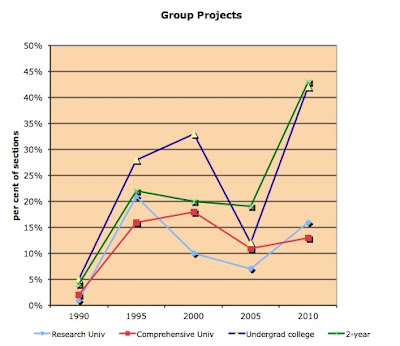This past spring, the National Research Council of the
National Academies released its report, Discipline-Based Education Research: Understanding and Improving
Learning in Undergraduate Science and Engineering [1]. The charge to the
committee writing this report was to synthesize existing research on teaching
and learning in the sciences, to report on the effect of this research, and to identify
future directions for this research. The project has its roots in two 2008
workshops on promising practices in undergraduate science, technology,
engineering, and mathematics education.
Unfortunately, between 2008 and 2012 undergraduate mathematics
education dropped out of the picture. The resulting report discusses
undergraduate education research only for physics, chemistry, engineering,
biology, the geosciences, and astronomy. Nevertheless, it is an interesting
report with useful information—especially the instructional strategies that
have been shown to be effective—that is relevant for those of us who teach
undergraduate mathematics.
The studies that are described are founded on the assumption
that students must build their own understanding of the discipline by applying
its methods and principles, and this is best accomplished within a
student-centered approach that puts less emphasis on simple transmission of
factual information and more on student engagement with conceptual
understanding, including active learning in the classroom.
The great strength of this report is the wealth of resources
that it references and the common themes that emerge across all of the
scientific disciplines. A lot of attention
is paid to the power of interactive lectures. Given that most science and
mathematics instruction is still given in traditional lecture settings, finding
ways of engaging students and getting them to think about the mathematics while they are in class is essential
for increasing student understanding.
The recommendations of effective practice range from simple
techniques, such as starting each class with a challenging question for
students to keep in mind, to transformative practices such as collaborative
learning. A common intermediate practice involves student engagement by posing
a challenging question, having students interact with their peers to think
through the answer, and then testing the answer. In some respects, this is more
easily done in the sciences where student predictions can be verified or
falsified experimentally. Yet it is also a very effective tool in mathematics
education where a well-chosen example can falsify an invalid expectation and
careful analysis can support correct understanding. But most important is that it forces to try to
use what they have been learning.
In large classes, this type of peer instruction can be
facilitated by the use of clickers. The report does include the caveat, with
supporting research, that merely using clickers without attention to how they
are used is of no measurable benefit.
The greatest learning gains that have been documented occur
when collaborative research is incorporated into the classroom. The NRC report
includes many descriptions of how this can be accomplished in a variety of
scientific disciplines. It also references the research that has established
its effectiveness. Again, attention to how it is done is an important component
of effective practice.
Two of the areas that are identified as needing more
research are issues of transference (see my September column on Teaching and
Learning for Transference) and metacognition. Usefully, the authors point
out that there are two sides to transference: the ability to draw on prior
knowledge and the ability to carry what is currently being learned to future
situations. Metacognition is an important issue in research in undergraduate
mathematics education, especially for those studying the difference between
experts and novices engaged in activities such as constructing proofs. Experts
monitor their assumptions and progress and are prepared to change track when a particular
approach is not fruitful. Novices are more likely to choose what to them seems
the likeliest approach and then ignore alternatives.
In sum, this is a useful and thought-provoking report. I
wish that it had included undergraduate mathematics education research, but
perhaps that omission can be corrected as we move forward.
[1] National Research Council. 2012. Discipline-Based Education Research: Understanding and ImprovingLearning in Undergraduate Science and Engineering. S.R. Singer, N.R. Nielsen,
and H.A. Schweingruber, eds. Washington, DC. The National Academies Press.
























